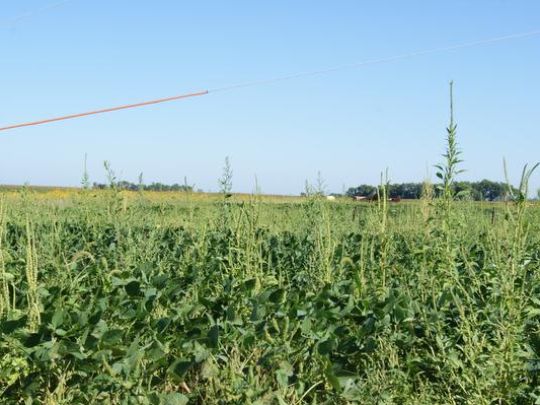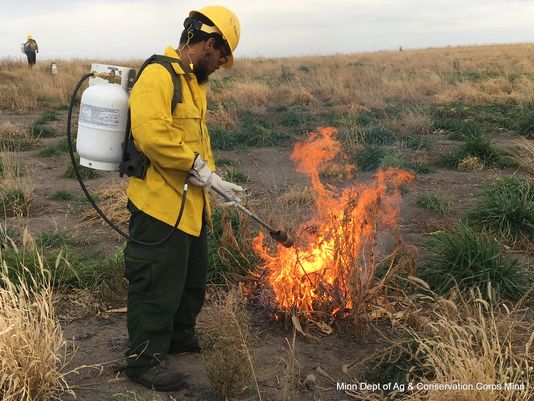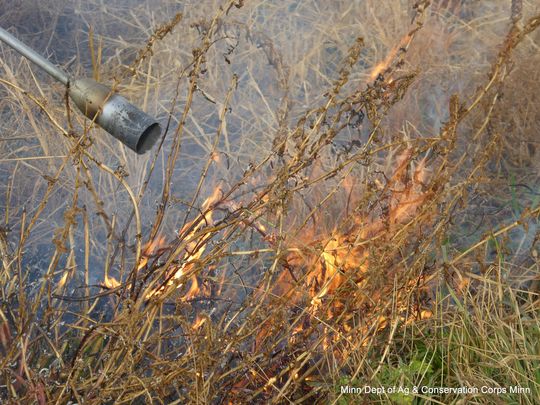Linda Huff’s Dodge minivan is filled with garbage bags stuffed with Palmer amaranth she dug up this fall from 20 acres planted with prairie grasses and flowers near Jefferson, Iowa.
It took the 77-year-old about 15 hours to remove the plants, which can quickly grow up to seven feet tall. She carefully placed flags where she removed each plant, knowing seeds from the highly invasive weed could easily sprout again next spring, moving from field to field, crowding out corn, soybeans and other cash crops.
Farmers in Iowa, Minnesota and some other Midwestern states have learned that the native grasses and prairies planted to help butterflies and other pollinators inadvertently have spread the noxious weed. It has overrun and choked fields across the southern U.S., where it has proven to be resistant to several herbicides, including widely used glyphosate.
“It’s a huge threat to agriculture,” said Huff’s son Steven Bortz.
Minnesota farm leaders are so concerned about the aggressive, prolific weed that they attacked it with blow torches last fall, seeking to destroy seeds that can reach up to 500,000 on each plant. The weed is in 30 fields, filter strips and plantings in two counties in the state.
 Palmer amaranth, which can dramatically cut crop yields, has been identified in 49 of Iowa’s 99 counties, nearly 10 times as many counties than at the start of the year, said Robert Hartzler, an Iowa State University professor of agronomy.
Palmer amaranth, which can dramatically cut crop yields, has been identified in 49 of Iowa’s 99 counties, nearly 10 times as many counties than at the start of the year, said Robert Hartzler, an Iowa State University professor of agronomy.
“We have so much Palmer amaranth in the state, there’s no doubt it will establish and move,” said Hartzler. “It will have a significant economic impact.”
At risk are Iowa’s corn and soybean crops, which raked in some $13 billion last year. At its worst, Palmer amaranth can reduce soybean yield by 80 percent, and corn by about 90 percent, studies have shown.
Iowa State experts and agronomists across the state have been sounding an alarm about the weed’s widespread introduction in Iowa. But Hartzler and others say the federal government has been mostly silent. It still hasn’t alerted Iowa farmland owners with up to 200,000 acres in pollinator conservation programs about the weed.
“We’re frustrated,” said Hartzler, who adds that growers could have begun fighting the weed’s march through fields last fall. “All those plants we allowed to survive this year will produce hundreds of thousands of seeds, and that compounds your problems exponentially. The costs will be significantly higher next year than had we responded this year.”
Tough to Combat
U.S. agriculture agencies are working with ISU, the state and other agencies to determine what actions landowners can take on conservation fields. Owners of Midwestern land where the weed has been introduced through conservation seed mixes have run into complications trying to control it.
While Hartzler’s testing isn’t conclusive, he was able to kill Palmer amaranth grown from conservation field seeds with glyphosate, the active ingredient in Roundup, the world’s mostly widely used herbicide. That gives Iowa an advantage over southern states, where the weed is resistant to several herbicides, including glyphosate. It has forced growers there to frequently till fields or hoe weeds by hand. Some farmers have illegally used a herbicide not designated for spraying crops mid-season in a desperate attempt to control the weed. The unintended drift damaged crops on thousands of other acres, including peaches, tomatoes and other sensitive produce, said federal officials, who are investigating.
Even if Palmer amaranth can be killed with herbicides in Iowa, it can’t be wiped out when the fast-growing plant reaches a certain height, making it extremely hard to control. And using glyphosate would kill more than Palmer amaranth in native prairie fields planted with sunflower, coneflowers and other forbs that help feed monarch butterflies, bees and other pollinators whose populations are threatened by reduced forage.
“These prairie plants are slow to establish, so the big concern is that the Palmer will thrive while the perennials get established,” Hartzler said.
Once the prairie flowers are established, they’re expected to crowd out the weed, he said. Frequent mowing could suppress Palmer amaranth if landowners actively manage the conservation plantings. However, many landowners believe the conservation land “can take care of itself,” Hartzler said. “It’s not a cash crop, so it’s ‘out of sight, out of mind.’”
He warns, though, that Iowans have “a grace period” when the weed will be relatively easier to manage, “compared to what it will be 10 to 15 years from now.”
“The real concern is next year, when it will start to spread because of the dramatic increase in seed [production],” Hartzler said. “In those fields, Palmer amaranth will produce millions of seeds.”
The seeds get caught on tires and mowers and carried to nearby crop fields, he said. They’ve also been spread by birds in neighboring states, studies show. “It’s going to be a lot more difficult to deal with,” Hartzler said.
Who Pays?
Bortz wants to know who is responsible for the added costs and reduced yields Iowa growers could see with the spread of Palmer amaranth. Growers face increased herbicide costs and increased tillage for conservation fields with the rise of Palmer amaranth. They potentially could have to hire crews to cut the weed. No one could estimate how much more the weed will cost farmers.
“I’m concerned about how it got there. Who’s responsible? Who’s liable?” said Bortz, who hired the local Natural Resources Conservation Service to plant his family’s pollinator acres. “They say it’s not a noxious weed, so they’re not liable.”
Iowa and U.S. farmland owners get paid to take cropland out of production under the federal Conservation Reserve Program. Pollinator programs encourage farmers to plant flowers and grasses that will attract bees, butterflies and other pollinators that support $25 billion in fruits, vegetables and other ag production. Landowners get annual rental payments and are paid part of the cost to plant pollinator mixes and manage the fields.
Tom Vilsack, the U.S. agriculture secretary who was in Iowa recently, called the accidental introduction of Palmer amaranth in conservation seed mixes an “isolated incident.”
“There are issues that crop up from time to time, and we’re going to adjust and deal with them,” Vilsack said.
Iowa secretary of agriculture Bill Northey wants the USDA to allow farmers and landowners to use spot herbicides in conservation pollinator habitats to kill Palmer amaranth.
“You don’t want to do things that destroy the competing grasses and forbs around the Palmer amaranth,” said Northey. “At the same time, you want to reduce the seed production.”
Northey said officials also are discussing whether some conservation fields that become overrun with Palmer amaranth can be destroyed and replanted.
“There are a lot of conversations about what needs to be done, what needs to be allowed, and what”s effective,” Northey said.
Bortz’s neighbor, Carroll Perkins, said he’s not sure if he has Palmer amaranth in his conservation planting. But if he finds it next year, he plans to buy out his conservation contract and eliminate it.
John Whitaker, executive director of the Iowa Farm Service Agency, said he understands growers’ concerns. “Producers will have to do what they feel is best for their operations,” he said.
In addition to conservation fields in 35 counties, Palmer amaranth has been found in crop fields in 14 Iowa counties. But Hartzler believes the weed could be in as many as 80 counties. Palmer amaranth is difficult to correctly identify because it looks like a pigweed cousin, waterhemp, a widespread weed that’s resistant to glyphosate in Iowa.
Oddly enough, that could help Iowa. Hartzler said most growers use another herbicide in addition to glyphosate, to kill waterhemp in corn and soybean fields. He estimates “99.9 percent of crop fields have waterhemp, so farmers are already targeting pigweed. That will slow the rate that Palmer spreads.” But unlike Palmer amaranth, waterhemp doesn’t reduce yields, so farmers aren’t under pressure to completely kill the weed each season, enabling it to gain herbicide resistance.
“As you drive across Iowa in September and look across soybean fields, probably over 50 percent of soybean fields have waterhemp poking above the soybean canopy,” Hartzler said. “Farmers have learned it doesn’t affect yield. It doesn’t slow their combines down. They say, ‘Why spend more money to control the last 10 to 20 percent of waterhemp, if it’s not costing me anything in the short-run?’ With Palmer, if they accept incomplete control, it will reduce their yields.”
Lawsuits Expected
Northey wants the state to put Palmer amaranth on its noxious seed and weed lists. The seed designation is to prevent noxious seed from entering the state, and the weed law could give farmers, landowners and others more tools to fight its spread.
But the state ag secretary said he’s unsure that declaring Palmer amaranth a noxious seed and weed when it first arrived in the state in 2013, likely in livestock feed, would have protected Iowa.
“It’s not like the seed would have not been in the mix if it was put on the list,” said Northey, adding that officials are still trying to determine how the Palmer amaranth seed got into Iowa’s conservation mixes.
Some farmers have reported the seed tags indicated there was no weed seed in the pollinator habitat mix.
“It's certainly important to take a stand and say, ‘We don't want that here, and you’re in violation of our seed laws,’” Northey said. “But is that preventative or is it just something you’re able to challenge legally afterward?”
Northey, like Bortz and others, believes the added costs farmers and landowners run into fighting Palmer amaranth could spark a rash of lawsuits. “I have a feeling there are lawsuits brewing,” Bortz said.
Taking Up Blowtorches
 Minnesota placed Palmer amaranth on the state’s noxious weed list in 2014, and this year listed it as a prohibited weed seed.
Minnesota placed Palmer amaranth on the state’s noxious weed list in 2014, and this year listed it as a prohibited weed seed.
“That helped us get some boots on the ground,” said Anthony Cortilet, a noxious weed coordinator at the Minnesota Department of Agriculture.
Since Palmer amaranth was discovered in just two counties, Minnesota contracted with the Conservation Corps of Minnesota & Iowa last fall to use propane blowtorches to spot-kill the weed seed.
Wrapped head to toe in flame-resistant gear, the specialized crew burned Palmer amaranth plants in five plantings that hadn’t been mowed to the ground yet. They’re hoping to reduce the number of new Palmer amaranth weeds that pop up next spring.
“We want to eradicate the weed, not just control it,” said Cortilet, whose team is putting together plans to beat back the weed next spring. They, too, want to use herbicides to spot-kill Palmer in conservation reserve fields.
The weed isn’t resistant to glyphosate in Minnesota conservation plantings, either.
 “It might be an insurmountable task—it’s not lost on us what’s happening in [Iowa]—but we’re giving it the best try we can because we know we have a limited window of opportunity,” said Cortilet, adding that the state provided about $50,000 to battle the weed in Minnesota.
“It might be an insurmountable task—it’s not lost on us what’s happening in [Iowa]—but we’re giving it the best try we can because we know we have a limited window of opportunity,” said Cortilet, adding that the state provided about $50,000 to battle the weed in Minnesota.
The state continues to investigate, but it believes the seed is tied to one pollinator seed mix, he said.
Burning the plant signals to farmers the importance of stopping the weed, Cortilet said. “They think we’re absolutely insane, and they couldn’t be happier that we are.”
He said the state needs farmers to climb on board to fight Palmer amaranth. “They will be the biggest help in identifying the plant and learning what works and what doesn't.”
Source: The Des Moines Register